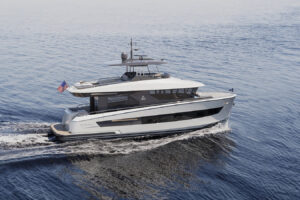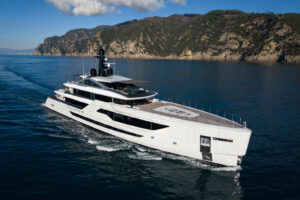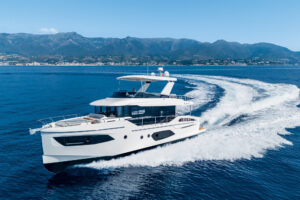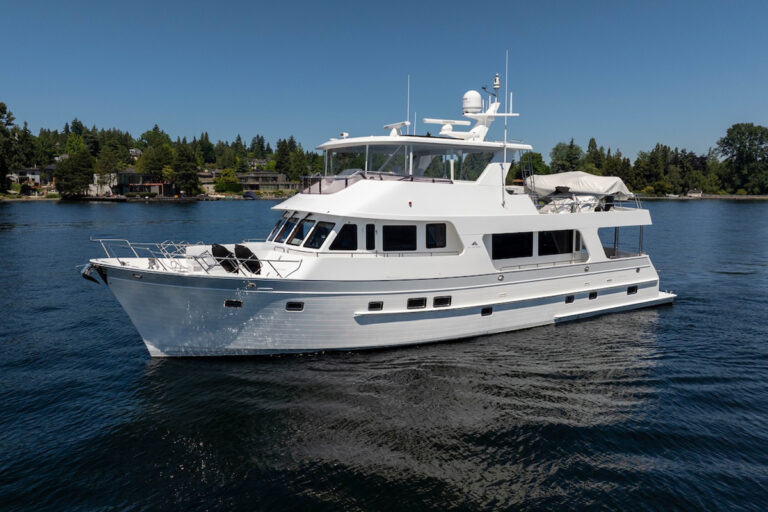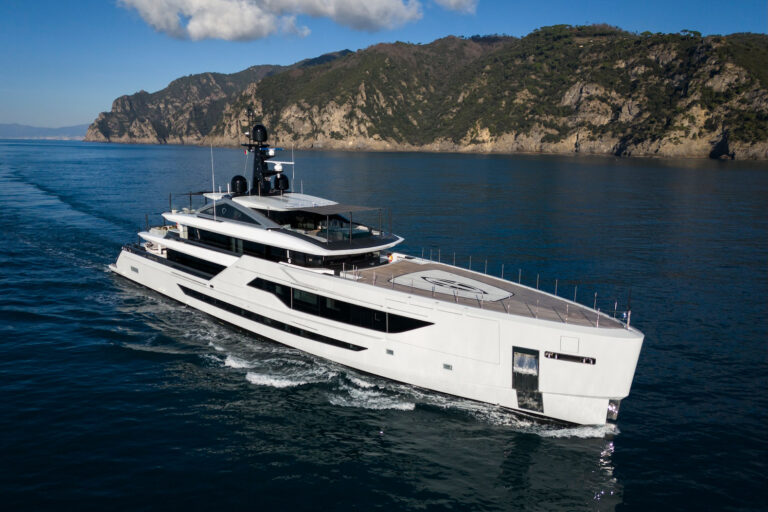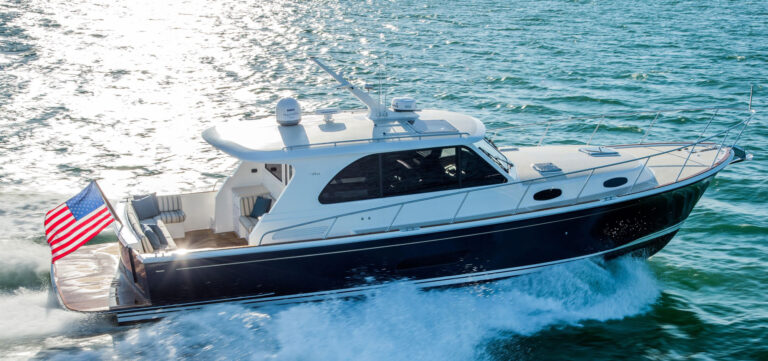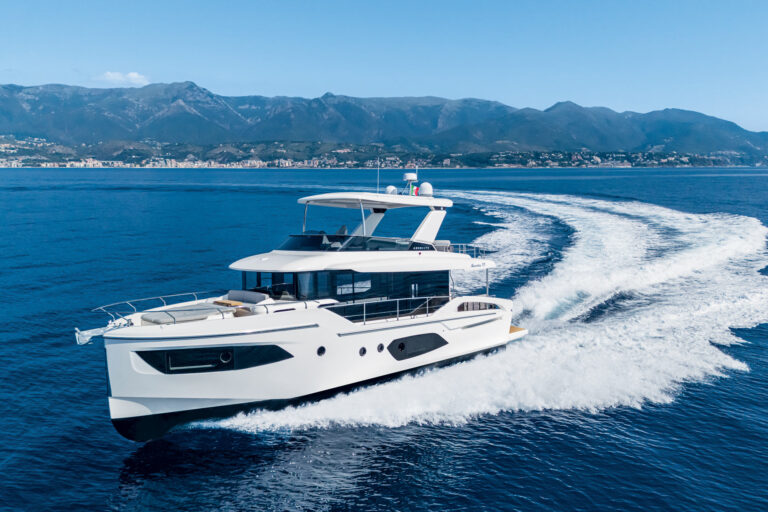It was day three of the Pelican Bay Tournament. Most crews had opted for a lay-day the previous day, and the northeast wind had only slightly abated overnight off Ft. Pierce, Florida. The messy seas were building 4 to 6 feet-and leaning toward the upper end of that range. Before casting off, I hesitated hopping on board the new Riviera 51 Aussie Girl, figuring the seas and a crowd of 10 guys were not a stellar combination for fairly evaluating the convertible. On the other hand, I thought, these factors could create the ultimate test.
Like me, Captain Paul DeWolfe, whose regular ride is a cold-molded Whiticar, was anxious to see if this new yacht could run with the big dogs-there were some mighty players lined up pulpit to transom for the 7:30 a.m. start. Seven hours of tournament fishing later, Aussie Girl had proved her worth: She is a capable platform to chase and fight fish, and a highly comfortable family cruiser.
DeWolfe throttled up as we entered a substantial head sea at about 23 knots. King-size sheets of green water blasted by as I sat on the cockpit freezer talking with mate Tim Bailey. There was no place to hide-water poured off every appendage. This was no reflection of the dryness of the 51’s ride, though; I scanned the horizon and saw spray being thrown around everywhere on every boat. We slowed to a comfortable 17 knots, and while Aussie Girl did not overtake anyone, no other boat appeared in a hurry to pass us.
After a full day of fishing, I learned one of the 51’s best attributes is her flying bridge, which can handle 10 burly guys. I am prone to mal de mer, so my only choice (the cabin was not an option) was to join the crew on the bridge. A few stood, but most sat on the straight portside settees or L-shape ones to starboard. We chatted as the captain headed east to 140 feet of water, an area where two shrimp boats were working.
The flying-bridge helm is offset to starboard, a position that creates more room for guests. The placement does, however, slightly obscure the port transom corner from view. A textured surface reduces glare on the forward face of the console. Riviera has built in adequate stowage. The bundling and routing of the wiring is satisfactory, but it’s a bit disorganized under the helm.
A hatch covers the ladder opening. Many manufacturers employ this design, but I am not a fan of the concept-the hatch seems to be more hindrance than help. I might feel differently if I had small children aboard. It will, though, keep cool air from spilling wastefully down when the optional 24,000-BTU air conditioner is engaged.
Sight lines on the bridge are terrific, and remarkably, when lying facing forward on the settees, you can see the bow without raising your head. The forward bulkhead is low and notched, and kudos to whomever made the canvas; the forward opening panel is matched to the V-support of the tower legs, so the zippers obscure the supports.
I spent some quality time behind the wheel and found the Riviera 51 responsive. She is a bit narrow in the beam-a smidge over 16 feet-but that helped her slice through the tall head sea. There was minimal pounding at a sensible speed, and landings were extremely soft.
We trolled with ease, mostly in the trough. Once we were on a fish, a twinkle hit the ol’ captain’s eye, and he juiced the throttle and threw a smirk in my direction. The moment of truth had arrived. As the 51 backed down, her stern rose slightly into the sea as we followed the high-visibility monoline tethered to a sailfish. The cockpit remained dry as a bone, and the 51 pivoted with ease.
With 825 hp MTU Series 60s-the horsepower range I recommend-her sweet spot is 2030 rpm, which produced a 25-knot cruise at 60 gallons per hour. At this speed, during our break for the barn, she handled the following sea with minimal attention to the helm. The standard 8 hp bowthruster made docking effortless.
Though the 118-square-foot cockpit is functional and clean, it would be tight if you added a full-size fighting chair. The gunwales are fishing friendly-comfortably low-and have six stowage compartments beneath. In-sole fishboxes are large, and a bait well is set into the transom. A nice item is a small pop-up cleat on the gunwale, for securing a fender or tender.
Against the house is a large, top-loading freezer, and a sink is set into the door leading to the engineroom. The customary saloon window is above, though it is an unconventional slider. I am uncertain what benefits an opening window here provides, since its position will limit fresh breeze. I would prefer a fixed window. A bank of switches for the cockpit amenities, such as the baitwell pump, juts out on the starboard side, at about the shoulder height of a crewmember sitting on the ledge. In rough seas, these could be switched on or, worse, broken off. A simple solution might be rocker switches. The saloon door is wide and hinged with strong, matte-finish hardware.
Riviera has finished the saloon with handsome joinerwork, a spacious dinette, a Bose sound system and upholstered accents that create a look of refinement. Her saloon is user friendly, inviting guests in with angled cherry joinery (teak is optional) and a large settee. The overhead rod-stowage compartment has a door that opens electrically. A wine cooler is conveniently situated for all to enjoy. The dinette accommodates a family of five. Wood valances spill cool air down, and two stout handrails run centerline on the overhead for safety.
Her galley, two steps down, is ideal for cruising, with drawer-style refrigerators, a separate freezer, Corian countertops with raised fiddles, an Amtico sole and a fine view of the scenery. A large stowage area below the galley is accessed through a hatch. I believe this area would be better utilized by repositioning some equipment in the engineroom; cruising families could pack the area with provisions.
As owners and guests head down to the 51’s three staterooms and two heads, they will enjoy the 2-foot-wide companionway, lighted steps and stacked washer and dryer units.
Each cabin exhibits the builder’s attention to detail. All have 6 feet, 7 inches of headroom, under-berth stowage, and hatches for natural light and fresh air. Island berths inhabit the master and VIP, and the second guest cabin has wide upper-and-lower berths.
This convertible has a sporty look and feel to her. Moreover, she has a solid bottom, with core in the topsides, deck and house. A watertight crash bulkhead is forward; the engineroom is outfitted with watertight bulkheads, as well.
The engineroom has soft patches above. All service items are accessible, though I would like to see a sump for the air-conditioning runoff, to keep it from trickling into the bilge. The area is finished professionally, but the builder should consider using a glossier finish between the engines and stringers, to resist the inevitable oil drip.
After our full day of foul-weather fishing, Aussie Girl proved able to stand her ground when it came to raising fish, battling adverse conditions and handling a large crowd. It will not be surprising to see more of these Australian-built yachts fishing and cruising the waters far from the crocs and kangaroos of their birthplace.
Contact: Riviera Marine, (561) 721-4100, www.rivieramarine.com. For more information, contact: (866) 922-4877

